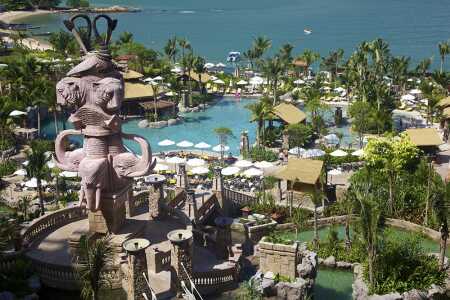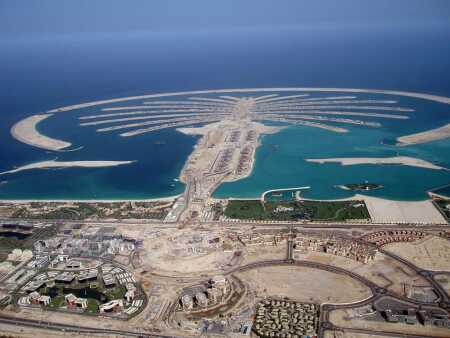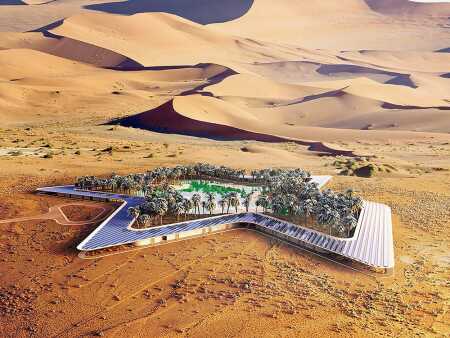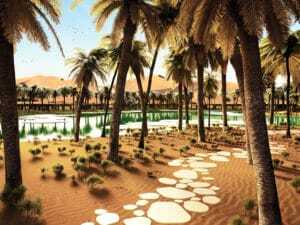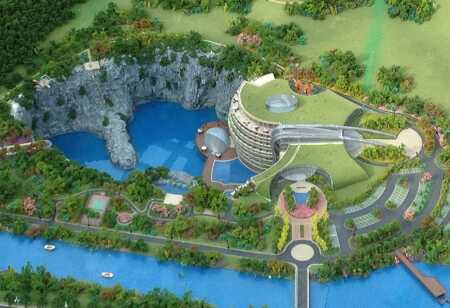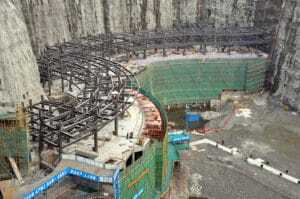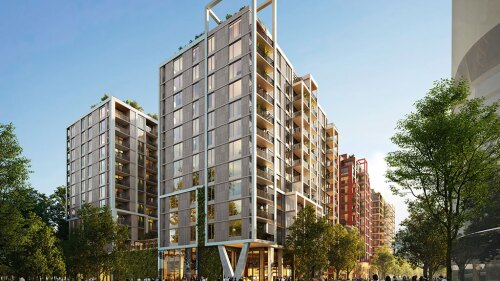When Centara, an Asian hospitality chain, decided in the late 2000s to build Grand Mirage Beach Resort, an upscale destination getaway complex in the Thai city of Pattaya, it picked a location blessed with an alluring coastal environment. But in a global market in which many resorts are in a high-stakes competition for vacationers, an expanse of sandy beaches and the serene panoramas of the Gulf of Thailand were not enough to guarantee success for the $115 million project.
So the hotel chain brought in FORREC, a Toronto-based design firm whose specialties include creating water attractions that go beyond what nature has to offer.
Around the 500-room hotel, FORREC concocted a sprawling artificial environment of simulated caverns, waterfalls, and lagoons, all connected by body slides and a “lazy river” tube ride, as well as by meandering walkways and bridges for visitors preferring to stay out of the water and just gaze at the surroundings. To provide context for the water features, the designers set them against the backdrop of ornate artificial ruins of an imagined ancient lost city. It all seems to have worked, judging from the generally glowing reviews the resort now earns on travel websites.
As Eric J. O’Rourke, director of FORREC’s resort design division, explains, the biggest challenge of creating such attractions is making them seem not to be manmade. “You want to create an impression that the resort was built around a natural water feature,” he says. “When it looks as if the water body was already there, the resort seems to be nestled around it. And that makes the experience stronger.”
Grand Mirage is just one example of a rising trend of resort developments—artificial water features designed to make those destinations stand out from the competition. These attractions, both those built and those in the planning or construction stages, run the gamut from elaborate to outlandish. They include simulated lagoons, rivers, and waterfalls; hotels with submerged lower floors that allow restaurant diners to peer into the watery depths; artificial islands that form decorative shapes when viewed from the air; and even indoor ski slopes in places where it does not naturally snow.
While such enhancements can add millions of dollars to the cost of a resort development, industry analysts say the expense does not constitute an extravagance. They make the business case that a distinctive manmade water feature not only enhances a resort’s visibility, but also can provide a powerful economic advantage, allowing operators to attract more guests and charge higher rates, and attract business to bars and restaurants bordering the feature. And if a feature contains a recreational component—such as a waterpark—it also can generate direct revenue.
But the formula works so well that architects, designers, and developers are under pressure to come up with attention-getting, distinctive water attractions—and must grapple with the technical, economic, and environmental challenges of creating and operating them.
“I think that people expect today that if they’re staying in a high-end resort, they’re going to see some elaborate water features,” says David J. Sangree, president of Hotel & Leisure Advisors, a Cleveland-based firm that conducts economic analyses for the hospitality industry. “So the resorts have to meet that expectation.”
Striving for Distinctive
“The dilemma in this is that you can’t just copy what someone else is doing,” says industry consultant John Gerner, managing director of Leisure Business Advisors, based in Richmond, Virginia. “Instead, the formula is that you have to come up with something that no one’s thought of yet.”
That quest for attention-getting aquatic attractions has resulted in dazzling variety. In Chandler, Arizona, for example, the Sheraton Wild Horse Pass Resort, completed in 2002 at a cost of $175 million, has a 1.5-mile (2.4 km) replica of the Gila River. The waterway starts with a two-story waterfall and ends flowing into a 3.5-acre (1.4 ha) lake, with rapids, shallow areas, rock outcroppings, and sandbars along the way.
On the other side of the world in China, in a repurposed 295-foot-deep (90 m) quarry outside Shanghai, the Shimao Group is building a 340-room hotel on the rock face of the quarry wall. The bottom two floors of the hotel will be submerged in an artificial lake, with hotel windows allowing guests to look into an aquarium that will be built inside the lake. A waterfall will be installed at the far end of the quarry. “At night it will be illuminated, thus creating a part of the water show spectacle,” says Martin Jochman, the development’s project and design director.
But developers and architects have pushed the concept of manmade water attractions to another level in Dubai, a city in the United Arab Emirates that has worked energetically to become a major vacation destination. It is home to numerous exotic water features, ranging from Ski Dubai, an indoor mountain with manmade snow, to the Palm Jumeirah, a palm tree–shaped land mass that its developer Nakheel says is the world’s largest artificial island, measuring about 3.1 miles (5 km) in diameter and covering 1,500 acres (600 ha).
More spectacular attractions are on the way in the city. Meydan One, a massive residential and entertainment complex whose first phase is scheduled for completion in 2020, includes both a waterpark with a tower for bungee jumping and an indoor ski slope larger than that at Ski Dubai, according to the developer’s website. Another component of that project will be the world’s largest artificial lagoon, covering nearly 100 acres (41 ha).
Artificial Lagoons
The Dubai lagoon is designed by Crystal Lagoons, a nine-year-old international company that says it is involved in 300 such projects in 60 countries. Company founder Fernando Fischmann, a Chilean biochemist and real estate developer, came up with a particularly novel sort of water attraction.
The company’s artificial lagoons in some ways are like giant swimming pools, filled with water filtered and chemically disinfected to be free of the bacteria found in natural bodies of water. But Crystal Lagoons accomplishes this in a different way than does a swimming pool operator: instead of merely putting set quantities of chemicals in the water, Crystal Lagoons employs an extensive system of telemetric, remote-controlled sensors that continuously report on fluctuations in water quality, allowing operators to inject much smaller amounts of chemicals where needed.
“We use about 100 times less than a swimming pool,” says Uri Man, chief executive of Crystal Lagoons, U.S. division. In addition, an ultrasonic filtration system uses sound waves to coax sediment to fall to the lagoon bottom, where it is vacuumed up by a roving suction cart.
Unlike their natural counterparts, the company’s artificial lagoons are not a suitable habitat for fish or birds: “There’s nothing for them to eat in the water,” Man explains. But the artificial bodies of water, which vary from six to 12 feet (1.8 to 4 m) in depth, do create a setting for water sports such as swimming and paddle-boarding.
This solves a tricky problem for seaside resorts, Man says. “In most places around the world, the ocean isn’t really friendly for recreational use,” he notes. Creation of an artificial lagoon also makes it possible to increase the value of resort property by providing an additional waterfront area besides the spots that have ocean access.
Although its bodies of water are artificial, Crystal Lagoons says those features have a relatively light environmental footprint. Over the course of a year, one of the company’s lagoons will use about one-30th the water used by another popular resort amenity, a golf course, Man says. (To see what forward-thinking golf course operators are doing to slash their water use, see the article beginning on page 52.) In addition, “We can use almost any source of water,” Man says. The water for the massive Dubai lagoon, for example, will be treated brackish groundwater. That is a big plus in Dubai, where most of the limited potable water supply comes from desalination plants.
Evaporation probably will not be a major problem in Dubai because the humidity generally is high. But even in a more arid location, water loss from evaporation can be curbed by up to 50 percent through use of chemicals, says Carlos Salas, Crystal Lagoons regional director for the Middle East. “There are challenges that are specific to each environment, and our technology is specially calibrated to deal with each,” he says.
But Jennifer Languell, a Florida-based consultant with a doctorate in sustainable construction and founder of Fort Myers–based Trifecta Construction Solutions, questions whether that solution will work everywhere. “In dry climates, evaporation is really huge,” she says.
Iconic Land and Water Forms
Perhaps the most dramatic subgenre of artificial water feature is an iconic land form, such as the Palm Jumeirah, which was built in the 2000s by dredging 118 million cubic yards (90 million cubic m) of rock, soil, and sand from the Persian Gulf. After a stone breakwater and base were fashioned, sand was sprayed onto the palm tree–shaped form and compacted with a vibration process to create the land.
The project’s master planner was Lawrence W. Ziebarth, president and design principal at HHCP Design International, a division of Orlando-based HHCP. The land form, which can be seen from space, was not just created as an attention-getting device, he says. It created an additional 37 miles (60 km) of waterfront real estate where hotels and resort homes could be built. “All of those fronds on the palm are a way to create shoreline,” he notes.
Ziebarth and HHCP have continued to develop iterations of the iconic land form concept. One project is Ocean Flower, a flora-shaped island under construction off the coast of Hainan Island, China, that is planned to include a theme park, hotels, and shopping and dining facilities. “It’s a much different approach than the Palm because they wanted to generate as much land as they could,” Ziebarth says.
He also designed a project planned for a Chinese client that includes an island shaped like a dolphin, and two dolphin-shaped inlets. “It has both an iconic form by water and also by land,” he says.
Novelty versus Value
One big challenge for resort developers is determining whether a water feature’s cost is justified by its economic impact. “It’s difficult to evaluate something that hasn’t been done yet somewhere else,” Gerner says. “Is this going to be similar to putting in a waterpark at another park or building an indoor ski slope somewhere else?”
For a project designed to create a “wow” factor, he suggests, it ultimately may come down to an educated guess on what percentage the attraction might add to the resort’s occupancy rate. “If you can work out what that value is, you can probably say, ‘We shouldn’t spend more than the capitalized value of that income stream,’” he says.
A clearer case exists for artificial water features that also provide recreational opportunities, such as waterparks and artificial lakes and rivers suitable for watercraft.
Michael Brown, senior planner and landscape architect for Honolulu-based design firm WATG, cites the example of a resort complex in Macao with a 16-acre (7 ha) waterpark. In addition to allowing the resort’s five hotels to charge a premium for rooms by including waterpark access in the rate, “you can also allow public users to come in, and get revenue from them as well,” he notes.
Meanwhile, the quest for even more spectacular water attractions continues, and designers caution that the competition can sometimes get out of hand.
“If one guy does a water feature, the next guy says, ‘I’ve got to have two of those,’” Ziebarth says. “It’s not necessarily creating the best design for the project.”
Patrick J. Kiger is a Washington, D.C.–area journalist, blogger, and author.

